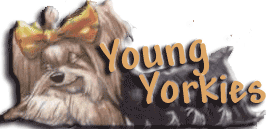The Yorkshire Terrier: Introduction to the Best Breed Around
Because they're so tiny
and have such splendid coats, many people think Yorkshire
Terriers are delicate dogs. Actually, it's better not to baby
these dogs too much. Excessive pampering confuses them. Common
sense care must be taken because of their size, but Yorkies
are little terriers. That means they love to play and
investigate. They are bundles of energy as puppies, though
older Yorkies can be quiet and settled.

The
Yorkshire Terrier is a member of the Toy
Group and was first registered by the AKC in 1885.
General Appearance
The general
appearance of a long-haired toy terrier whose blue and tan
coat is parted on the face and from the base of the skull to
the end of the tail and hangs evenly and quite straight down
each side of body. The body is neat, compact and well
proportioned. The dog's high head carriage and confident
manner should give the appearance of vigor and
self-importance.
Head
Small and rather
flat on top, the skull not too prominent or round, the muzzle
not too long, with the bite neither undershot nor overshot and
teeth sound. Either scissors bite or level bite is acceptable.
The nose is black. Eyes are medium in size and not too
prominent; dark in color and sparkling with a sharp,
intelligent expression. Eye rims are dark. Ears are small,
V-shaped, carried erect and set not too far apart.
Body
Well proportioned and very compact.
The back is rather short, the back line level, with height at
shoulder the same as at the rump.
Legs
and Feet
Forelegs should be straight, elbows
neither in nor out. Hind legs straight when viewed from
behind, but stifles are moderately bent when viewed from the
sides. Feet are round with black toenails.
Dewclaws, if any,
are generally removed from the hind legs. Dewclaws on the
forelegs may be removed.
Tail
Docked to a medium length and carried
slightly higher than the level of the back.
Coat
Coat quality, texture
and quantity of coat are of prime importance Hair is glossy,
fine and silky in texture. Coat on the body is moderately long
and perfectly straight (not wavy). It may be trimmed to floor
length to give ease of movement and a neater appearance, if
desired. The fall on the head is long, tied with one bow in
center of head or parted in the middle and tied with two bows.
Hair on muzzle is very long. Hair should be trimmed short on
tips of ears and may be trimmed on feet to give them a neat
appearance.
Colors
Puppies are born black and tan and
are normally darker in body color, showing an intermingling of
black hair in the tan until they are matured. Color of hair on
body and richness of tan on head and legs are of prime
importance in adult dogs, to which the following color
requirements apply: Blue: Is a dark steel-blue, not a
silver-blue and not mingled with fawn, bronzy or black hairs.
Tan: All tan hair is darker at the roots than in the middle,
shading to still lighter tan at the tips. There should be no
sooty or black hair intermingled with any of the tan. Color on
Body -The blue extends over the body from back of neck to root
of tail. Hair on tail is a darker blue, especially at end of
tail.
Headfall
A rich golden tan,
deeper in color at sides of head, at ear roots and on the
muzzle, with ears a deep rich tan. Tan color should not extend
down on back of neck.
Chest and Legs - A
bright, rich tan, not extending above the elbow on the
forelegs nor above the stifle on the hind legs.
Weight Must not exceed seven pounds.
History
The Yorkshire
Terrier made its first appearance at a bench show in England
in 1861 as a "broken-haired Scotch Terrier."
The
earliest record of a Yorkshire Terrier born in the United
States dates to 1872.
During the late Victorian era,
the Yorkshire Terrier quickly became a popular pet. As
Americans embraced Victorian customs, so too did they embrace
the Yorkshire Terrier. The Yorkshire Terrier became an
AKC-recognized breed in 1885.
So you want to
own a Yorkshire Terrier?
Grooming must be done on a regular basis. Although the
coat is easy to care for it is time consuming and necessary in
order to keep your dog in healthy condition.
The
Yorkshire Terrier can easily be injured by small children; if
you are considering a Yorkshire Terrier you must be able to
supervise the dog around small children. The Yorkshire Terrier
is an independent dog, but a devoted companion. Despite his
small size he is more than willing to act as a guardian for
his master.
This
information was obtained from AKC.org
Approved April 12, 1966
|
|



